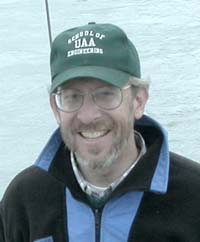
Orson Smith, the newest member of the council’s Port Operations and Vessel Traffic System committee, loves a good mental challenge.
Smith was recruited by council project manager Alan Sorum to the committee a little over a year ago. Working with the committee has given him a chance to understand the terminal and the Coast Guard’s Vessel Traffic System better.
“Port operations in the Valdez Arm represent truly challenging port and coastal engineering issues with the extreme weather,” Smith said, “The risk of an accident, even at a low probability, has a high cost.”
Originally from Kentucky, Smith moved to Alaska in 1973 to work as a mechanical engineer for the Corps of Engineers. In the early days, he rotated through various assignments, settling into a position doing hydrographic surveying and dredging ports.
“That was a time of high adventure,” Smith said, “I really remember it fondly, working around the waterfront of Alaska, at all the different harbors. I got to see a lot of Alaska.”
That work sparked an interest in civil engineering. The Corps paid for him to attend graduate school in Holland. The Dutch are known for their expertise in coastal engineering. After his studies, Smith came back to Alaska and began planning coastal and harbor projects, mainly working on feasibility studies, evaluating and analyzing proposed projects.
“It involved not just the detailed design but economics and environmental constraints, the full picture,” Smith said about the technical and intellectual challenges of the work, “You had to find a solution that would pass muster in the famous benefit-cost balance the federal government applies to projects.”
In 1983, the Coastal Engineering Research Center for the Corp of Engineers moved to Vicksburg, Mississippi. The head of the lab offered him a position.
“I could say it was a weak moment,” Smith said of the decision to move to the South, “My wife and I had two little kids then, and winters in Alaska were harder for us. So, under those circumstances we packed up and moved to Mississippi.”
Smith said he loved the work. The facility was great and the position gave him the opportunity for assignments all over the world.
“But,” Smith said, “I missed Alaska every single day I was gone.”
By 1991, he was back in Alaska, planning harbor projects for the Corps and teaching part-time at the University of Alaska Anchorage.
“Everything in my field, to me, is more challenging and more interesting in Alaska than it would be in California or another place.” Smith says.
In 1998, he went to work for the university full time as a professor in the School of Engineering.
Several of Smith’s projects over the years used emerging technologies in new ways. For his Ph.D. dissertation at North Carolina State University, he used an early version of an acoustic Doppler current profiler and fledgling GPS tracking to study currents in the Caribbean.
“It’s a very satisfying thing, the experience of taking new technology and using it for practical purpose,” Smith said.
Smith worked with National Oceanic and Atmospheric Administration, or NOAA, and the Corps’ Cold Regions Research and Engineering Lab to create an atlas of historical ice conditions in Cook Inlet.
During that same period, Smith contracted with NOAA to develop an observer’s guide for sea and glacier ice. Smith and the students working on the project took a trip to Columbia Glacier.
“There was something of a mystery at that time surrounding so-called “black ice,” Smith said. “There were different theories as to what that actually was.” Smith and the group took some samples of the black ice back to a lab in Anchorage.
“It turned out to be a nearly uniform suspension of really small particles.” Smith surmised that the particles came from runoff from the mountains, where the particles were trapped in glacial lakes and later became part of the glacier.
Recently, Smith has been getting back into teaching and research mode after a year on sabbatical and two years in the university’s administration as interim dean of the School of Engineering.
While he was dean, he worked on a volunteer project with graduate student Maria Kartezhnikova for the council. They looked at problems with loading oil onto tankers during severe weather, a common occurrence in Port Valdez.
Smith has been working on several educational partnerships between the university and other organizations. For one of those, Smith helped AVTEC, Alaska’s Institute of Technology, on their maritime simulator.
“AVTEC has the only U.S. Coast Guard certified ice navigation curriculum in the U.S. right now.”
Smith is now working with Seward’s SeaLife center on a citizen science program that will collect data about coastlines.
“We are just kicking off a program of volunteer observers of beach processes, called the Alaska Corps of Coastal Observers,” Smith said, “Observers will report their observations through a website and long term records and trends will be displayed there.”
Smith is excited about his chance to get involved with the council.
“The council is a remarkable effort and a model for the world, getting citizens involved in what is mostly a non-controversial hand in affairs where high risks occur.”